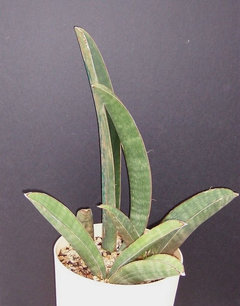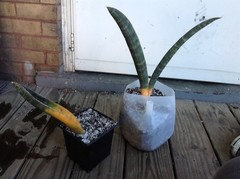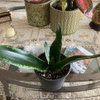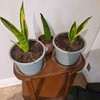S. hallii care???
I went to the conservatory yesterday to see their blooming titan arum, and lo and behold, the gift shop had a Sansevieria hallii plant. So, of course, I bought it.
I don't really know the best way to take care of this plant. The picture shows it in the bag coming home from the conservatory. It is still in its original pot with its original soil. I gave it a drink because the soil was completely dry, and I have put it on a table near a south-facing window with the light filtered out by some other plants.
Is there anything I should do differently from regular old S. trifasciata in caring for this species? It is so unique and I would hate to kill it!

Comments (26)
kataclysm
Original Author10 years agoOh, completely off-topic, BUT... here's a pic of the titan arum (the world's tallest flower). The bloom was much taller than I am, although it was already starting to decay after 24h. It also stank to high heaven.

Stush2049 Pitts. PA, zone 6
10 years agoThank you for the picture. I guess I would treat it just like the rest. I am no expert. See who else replies.
kataclysm
Original Author10 years agoOh hey Stush, you live near me. This hallii has at least 3 offshoots and looks pretty root-bound... Not sure of the best season to split the plant, but when I get brave, If you'd like one, I'll give you one!
Solar_Storm
10 years agoIf I were to guess, I'd call it a S hallii 'Lundi". All the standard hallii's I've seen have a "D" cross section, never deeply grooved. Here's my S hallii. As for care, treat it like most sans in that it will appreciate fresh soil, warmth, bright indirect light, and humidity, but not wet feet.

Enterotoxigenic00
10 years agoOk every one! Now I am jealous!
What great luck all are having!
Nice looking sans.
Karenbarbmock
10 years agoThanks for showing us the arum flower. It looks like an alien! Worth the trip to see it, plus you found your sans too.
BarbStush2049 Pitts. PA, zone 6
10 years agokataclysm,
We may bump into each other fighting over the clearance rack at Lowes'. Ha ha. Just kidding. Thank you for you offer but I have much more than I can handle right now. I would separate them come spring after the winter killing season is over. You can give mine to Enterotoxigenic if you wish.
I live near the old Pittsburgh Airport in south-west Pitt.
Stushkataclysm
Original Author10 years agoLOL! I'm in Wilkinsburg, so unless you like the Lowes at the Waterfront, we'll probably keep out of each others' paths. Just stay away from the K-Mart in Edgewood! (J/k)
laura1
10 years agoKat, your hallii looks like it is dehydrated.
As for care: mine is outside all year exposed in summer and winter. In the summer we have down pours of rain and this guy takes it. In winter we have very little rain and I seldom supplement. Basically it is very forgiving. Of course you will have to adjust your care to your climate but it should do OK for you.noki
10 years agoI think Hallii is probably more prone to rot than the standard trifasciata (which as everyone knows is very forgiving as a houseplant), and Hallii should be treated more like a succulent. Mine had a huge underground tuber and I had to put it in a big pot (to get it deep enough to stand up), but it rotted. Make sure it gets some decent sun, and draining soil. Sitting in damp soil inside the house = bad.
kataclysm
Original Author10 years agoThanks for the tips, laura and noki! It's in a pretty well-draining mix right now and I've basically been waiting for it to get pretty dry, then drenching it. I anticipate needing to err on the side of dryness for the winter months.
It's been a lot happier in its spot than I expected and I'm actually a bit concerned about what to do with it. Over the past week or so, I noticed the (plastic) pot getting deformed-looking. Then, today when I checked on the plants, I noticed that the entire pot was balanced on one corner -- pups have suddenly sprouted out of the bottom of the pot! (Apparently it likes my watering schedule?)
Is it too late in the year to divide this plant? I am unsure of the best course of action...
Stush2049 Pitts. PA, zone 6
10 years agokataclysm,
Normally, I would say no, but if you got a warm spot for it this winter, go for it. I like to use Root-tone on the cuts. Can't hurt. Don't forget to let the cuts heal before planting.
Stushnorma_2006
10 years agoThe same as you do any other San. or succulent, is it is a rooted plant. give a gentle tug on the leaf and it will let you know if it has roots.I must quit now, my hand is getting tired. The right hand is damaged. Norma
kataclysm
Original Author10 years agoSplit the plant last week, got 3 small plants and a mama plant. Mama could probably have been split into 2 again herself, but I didn't want to risk killing both halves because of how very tangled the root system was. I let the cuts callus over before replanting, and potted everyone up in a well-draining mix. The one on the left is the one that came out the bottom of the pot. The one on the right already had such a big root system, I couldn't fit it into any of the pots I had on hand, so I improvised :) I actually really like how the clear plastic shows the moisture level and root system of the plant... Maybe I'll look into getting a glass drill and turning vases into planters for some of my other plants!

kataclysm
Original Author10 years agoHere's Mama Plant back in her spot near the window... The leaf edges always look brown on this plant. When I bought it, the plant was completely dried out and in severely compacted soil, and apparently the browned edges/tips are permanent. Good thing I like my plants with a bit of 'character'.... ;)

sanny2016
7 years agoSadly this week my single leaf of S. Hallii 'striations" rotted at the stem. I NEVER should have watered it recently. This is the second sans plant that I've lost this winter. Clearly I must not water my sans plants again until spring!! (My sans plants are growing in front of bright windows here in Washington DC. It's warm during the day, and night time temperatures get down to the mid-60's.)
I've cut the leaf above the rot, and am letting it dry before putting it in soil in hopes that it will not rot further, and will take root. It's a gorgeous variegated leaf that I got late last year from JC on Ebay. I assume that if I can get a new plant out of it, it will revert solid S. Hallii. (?) Will keep you posted on what happens. Wish me luck!
woodnative
7 years agoGood luck! There is slight chance of getting a variegated cutting from it....especially since there are a lot of fine yellow and green lines on it, but you are correct in that it will most likely produce all green or albino offsets. Still worth a try. So this was a growing plant before (not just a rooted leaf)? A plant that I have always admired, and this one looks like it had a nice balance of variegation! What type of soil mix do you have your Sans in? What are the room temps? I have no trouble watering my Sans over winter if they are getting sun. A few I have in a warm room under lights at work need watering twice a week. Those on my windowsills (I am in New Jersey so further north than you) get watered every week or three (smaller pots more often than larger pots), but I always water on the mornings of a sunny day to let any excess moisture disappear before sunset. Sansevieria trifasciata cultivars need more watering than hallii though with its thick leaves. Keep us updated!!
Stush2049 Pitts. PA, zone 6
7 years agoSanny, Don't beat yourself up too much. I have lost a few Gold Hahnii this year from center stem rot. I think water played a small roll. Plant was going downhill and leaves started to shrivel up and after watering, rotted. I've seen some that just shriveled up to nothing with out watering. I suspect cold played the most roll in this. For some fussy ones, I try to keep them at 70 or higher. If you can give them 85 degrees F and bright (not full sun) light, water away all you want. But let the temp go down to 60, death. This is not for the all green verities.
sanny2016
7 years agoThank you, woodnative! I got this variegated hallii originally as a single leaf growing out of a section of rhizome with some roots. The soil that I now use is a combination of Bonsai Jack's Cactus and Succulent gritty mix and a commercial cactus and succulent mix. (Bonsai Jack's is very pricey, so I add some commercial C & S mix to make it go farther.) Before I got the gritty mix, I had been using straight commercial cactus and succulent mix -- and that was my second mistake. When I dumped out the rotted section I noticed the sandy soil at the bottom of the clay pot was still a little damp. Clearly I needed a better draining soil and now I have it.
I keep a thermometer near where my plants are that tracks daily high and low temperatures. Today it says that the overnight low was 64, yesterday's high was 82, and currently it is 77. I thought such a temperature range might be warm enough for me to do a little watering throughout the winter, but now I'm going to hold off except a little water for trifasciata cultivars that are getting wrinkled. You're lucky to have growing environments both at work and at home that are so warm and bright for your Sans!
sanny2016
7 years agoThanks, Stush. I've certainly learned through your experiences with your Gold Hahniis that they are very fussy. I guess all the highly variegated plants are challenging. Interesting that it is the cold temperatures that contribute to rot, and that you try to keep your delicate plants at 70 degrees or higher! (I've seen the photos of your fish tank set up. What a nice environment!) Half my plants grow next to a bright southwest window and the other half grow next to a bright northwest window. I'm forever adjusting my blinds so the plants will get bright light, but not too much sun and not too much cold. I think I'll try turning the heat up at night.
woodnative
7 years agosanny think about getting one of those plant heating mats......at least for a couple small prized variegates. The heat is needed primarily from below.......as heat rises, and to warm the soil a bit. 'Golden hahnis', which are notoriously difficult and fussy for folks here, had been showing up in big box stores around the country, in growing in peat retentive soil.....so some growers were able to not only grow these to maturity, to propagate them from offsets, grow them in water-retentive peaty soils, and produce enough of them to ship them everywhere. When these plants are warm and actively growing they seem to survive moisture and grow well. I put my poor plants outside in the summer (I am in NJ) and they thrive. If we have a week of pouring rain (something I WISH we had last summer!) they thrive out there. In the winter, when it is cold, different story.
Stush2049 Pitts. PA, zone 6
7 years agoSanny, Sounds like a great growing envelopment you set up. Like Woodnative says, bottom heat is the best and most economical way to give the plants the heat they need. More light will also help. I lost some Sans in windows due to low light thru our winter as well as cold drafts (even with new windows). Seems the temp is always lower at the bottom of big windows compared to large open spaces.
I use a large mix of granite chips sold as poultry grit in feed stores. Large 40 lb. bag is about $8.50 which goes a long way. I have transplanted some hahnii two weeks ago that's going great now with about a 90% granite and potting soil. My all gold one is in 100% granite with a tray under it to keep the granite some what moist but dry at the same time?? Tricky set up. I still loose some during this time of year so good luck and keep us informed. It is how we learn here.
Russ1023 (central Fla)
7 years agoSanny, I'm sorry you lost your hallii Striated, it was quite a rare and hard to find sansevieria. Unfortunately your leaf should produce a regular hallii unless the offset arises from the variegated tissue, which would probably be an albino. That said, it's remotely possible it could produce another Striated, so keep your fingers crossed.
Extra-thick leaves like hallii are very capable of producing offsets over several generations. So once you take the initial offsets from the leaf, it should still be in good shape and can potentially produce another round of offsets if you repot and fertilize it. Repeat the procedure as long as the leaf has energy, but I'd say 3 generations is about max before it turns yellow and dies. So figuring 2 or 3 offsets each round, you could get 6 to 9 hallii's out of that leaf. If nothing else, good trading material.
Russ
sanny2016
7 years agoRuss, thank you for the encouragement! I am afraid to anticipate that my beautiful hallii leaf will eventually produce multiple new (probably regular) plants but I'll try. Very interesting that one can get as many as 3 generations of offsets from a single extra-thick sans leaf! Does another generation of pups only appear if the first set of offsets are removed?









Russ1023 (central Fla)